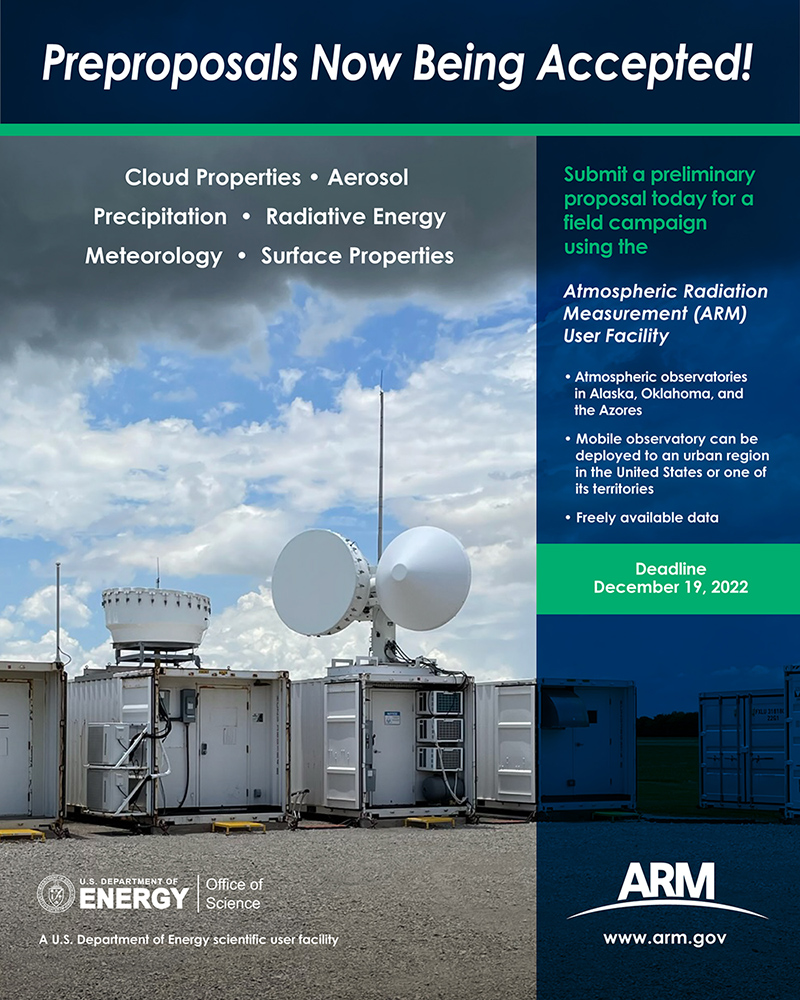ARM Call for Preliminary Mobile Facility Proposals Now Open
Published: 15 December 2022
Send in your field campaign preproposals by December 19

The U.S. Department of Energy is now accepting preliminary proposals from scientists to deploy an Atmospheric Radiation Measurement (ARM) Mobile Facility (AMF) for field campaigns to support the Biological and Environmental Research (BER) program’s interests in the science of urban regions and their interactions with the climate system.
Preproposals are due December 19, 2022. An AMF will tentatively be available for deployments starting September 1, 2024. The actual start date of the deployment may need to be adjusted by ARM depending on the location, details, and complexity of the proposed deployment.
AMF deployments are generally for periods of six to 12 months. Proposals requesting longer deployments must include strong science justification for the extended deployment period.
Proposed deployments must be within the United States or one of its territories. Priority will be given to deployments that focus on an urban region of interest to BER, such as those being studied by the Urban Integrated Field Laboratory projects; urban regions that are the focus of existing BER observational or modeling investments; or urban regions in the mid-Atlantic, Great Lakes, or Puget Sound areas.
Proposals do not have to deploy the AMF directly in the center of an urban region, as there may be logistical constraints, but may focus on other aspects of urban-climate interactions such as urban-suburban-rural gradients or the impact of urban regions on atmospheric properties.
Supplementary Measurements
An important characteristic of urban environments is spatial heterogeneity. To provide spatial context for ARM facility measurements, we encourage prospective principal investigators (PIs) to include discussion of existing sources of environmental measurements that could supplement the ARM deployment.
In addition, ARM will consider requests to deploy a small number of ancillary sites as part of the AMF deployment. The number of supportable ancillary sites will depend on the complexity of the requested instruments but is expected to be in the range of 1–3. Possible requested measurements (in order of complexity) include surface radiation and heat fluxes, near-surface aerosol properties (basic number and size distributions), or measurements of boundary-layer structure.
As ARM may not be able to support all requests, PIs should clearly prioritize any requested ancillary sites and measurements.
Aerial Components
The ARM tethered balloon system (TBS) may be included in the proposal request, but investigators should be aware that there are likely significant constraints regarding such deployments in urban areas.
Because of the complexities of aerial operations in urban environments, investigators are encouraged to consider several diverse candidate TBS deployment locations within the study domain to increase the chance of finding a location that meets science goals and constraints imposed by local regulations.
Investigators interested in requesting the TBS should read the TBS mission guidance and should include no more than three TBS missions per year in their request.
ARM’s crewed and uncrewed aircraft capabilities may NOT be requested as part of this solicitation.
Before Submitting Your Preproposal
Please read the ARM Field Campaign Guidelines for an overview of processes and requirements.
You are also invited to watch the recording of the November 9 ARM field campaign processes webinar. The webinar detailed the proposal process for ARM field campaigns as part of the fall 2022 AMF call.
Submitting Your Preproposal and Next Steps
Submit preproposals online through the field campaign preproposal form.
Proposals should make comprehensive use of the ARM facility, focus on BER strategic goals, and clearly indicate the value of the proposed AMF observations for improving earth system models.
Feedback on preproposals with encourage/discourage decisions will be sent to PIs by February 7, 2023. Full proposals will be due March 27, 2023.
More information is available on the guidelines page for the ARM annual facility call.
For help writing a successful proposal, read this ARM article containing five tips from campaign PIs.
Keep up with the Atmospheric Observer
Updates on ARM news, events, and opportunities delivered to your inbox
ARM User Profile
ARM welcomes users from all institutions and nations. A free ARM user account is needed to access ARM data.


















